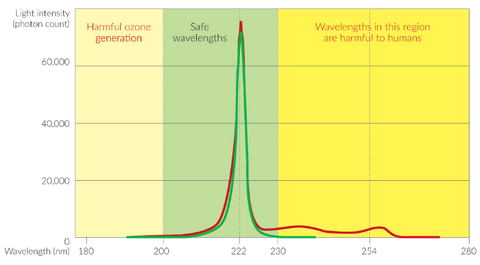Technology of 222nm Far UV-C
AFTER MORE THAN A CENTURY, THE NEXT STEP ON UV-C LIGHT DISINFECTION HAS FINALLY ARRIVED
Decades of UV light disinfection
UV light has been used for over a century to disinfect environments by removing viruses and bacteria. However, most UV light is also harmful to human tissue, which means people cannot be present in the room when the light is on.
At the same time, traditional disinfection lamps known as excimer lamps, are big, bulky instruments only fit for a lab.
However, this has all changed with 222nm UV-C
Putting an end to secondary emissions
UV Medico's Far UV-C lamp consists of a tube filled with a gas called krypton chloride. This gas has the unique property of emitting UV-C-light at 222 nm when a discharge is applied to it. When the lamp is turned on, electricity creates a discharge that excites the gas and after a short period of time, UV-C light at 222 nm is emitted.
A Far UV-C lamp without a filter emits light in a narrow band around a 222 nm peak, but also releases secondary emissions around 235 nm and 250 nm. These extra wavelengths are known as side-bands or side-emissions. These wavelengths are harmful to humans, but the unique and patented safety filter in UV222 blocks them before they are emitted into the surrounding environment.

The safety filter technology in the lamp from UV Medico is a thin filter that only lets through light at around 222 nm and blocks all other unwanted radiation. It works much in the same way as sunglasses with UV protection, blocking the UV radiation from passing through and entering the environment, making the light from UV222 safe.
Harmless to humans, harmful to pathogens
UV-C light at 222 nm is highly effective against viruses such as the SARS-CoV-2 because the proteins making up this virus, have an absorption spectrum with a peak around 220-230 nm.

This means that viruses heavily absorb light at the 222 nm wavelength, which is transformed into heat that deactivates the virus, including its capacity to infect and spread disease.
While this happens, the light remains harmless to human skin and eyes. The reason is that the top layer of the human skin is made of dead cells mostly made of proteins – and the same can be said about the top layer of the eye.
These proteins absorb the light at 222nm before it can penetrate the top layer and cause damage to the living tissue underneath.
Technology for a safer and healthier future
All of this technology is gathered in a small, compact, and low-maintenance Far UV-C lamp with a lifetime of +5,000 hours. When turned on in intervals, this lifetime is extended and the lamp can be used for years.
This is why UV222 is the most effective, the most affordable, and the safest Far UV-C lamp in the market.
Decades of UV light disinfection
UV light has been used for over a century to disinfect environments by removing viruses and bacteria. However, most UV light is also harmful to human tissue, which means people cannot be present in the room when the light is on.
At the same time, traditional disinfection lamps known as excimer lamps, are big, bulky instruments only fit for a lab.
However, this has all changed with 222nm UV-C
Putting an end to secondary emissions
UV Medico's Far UV-C lamp consists of a tube filled with a gas called krypton chloride. This gas has the unique property of emitting UV-C-light at 222 nm when a discharge is applied to it. When the lamp is turned on, electricity creates a discharge that excites the gas and after a short period of time, UV-C light at 222 nm is emitted.
A Far UV-C lamp without a filter emits light in a narrow band around a 222 nm peak, but also releases secondary emissions around 235 nm and 250 nm. These extra wavelengths are known as side-bands or side-emissions. These wavelengths are harmful to humans, but the unique and patented safety filter in UV222 blocks them before they are emitted into the surrounding environment.

The safety filter technology in the lamp from UV Medico is a thin filter that only lets through light at around 222 nm and blocks all other unwanted radiation. It works much in the same way as sunglasses with UV protection, blocking the UV radiation from passing through and entering the environment, making the light from UV222 safe.
Harmless to humans, harmful to pathogens
UV-C light at 222 nm is highly effective against viruses such as the SARS-CoV-2 because the proteins making up this virus, have an absorption spectrum with a peak around 220-230 nm.

This means that viruses heavily absorb light at the 222 nm wavelength, which is transformed into heat that deactivates the virus, including its capacity to infect and spread disease.
While this happens, the light remains harmless to human skin and eyes. The reason is that the top layer of the human skin is made of dead cells mostly made of proteins – and the same can be said about the top layer of the eye.
These proteins absorb the light at 222nm before it can penetrate the top layer and cause damage to the living tissue underneath.
Technology for a safer and healthier future
All of this technology is gathered in a small, compact, and low-maintenance Far UV-C lamp with a lifetime of +5,000 hours. When turned on in intervals, this lifetime is extended and the lamp can be used for years.
This is why UV222 is the most effective, the most affordable, and the safest Far UV-C lamp in the market.
